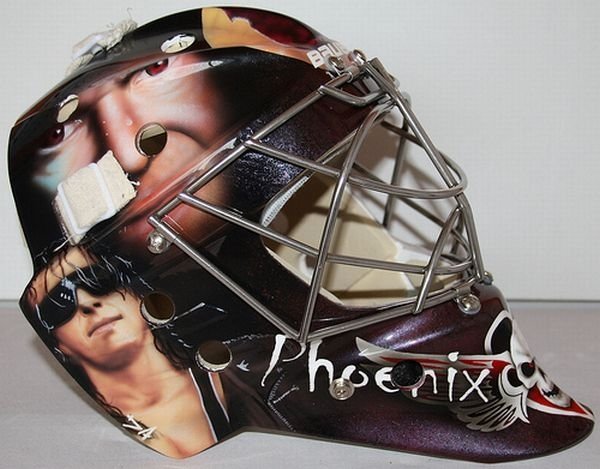|
|
Hockey Goalie Mask
|
The first goaltender mask was a fiberglass fencing mask donned in February 1927 by Queen's University netminder Elizabeth Graham, mainly to protect her teeth. In 1930, the first crude leather model of a mask (actually an American football "nose-guard") was worn by Clint Benedict to protect his broken nose. After recovering from the injury, he abandoned the mask, never wearing one again in his career. At the 1936 Winter Olympics, Teiji Honma wore a crude mask, not dissimilar to the one worn by baseball catchers. The mask was made of leather, and had a wire cage which protected the face, as well as Honma's large circular glasses.
It was not until 1959 that a goaltender wore a mask full-time. On November 1, 1959, in a game between the Montreal Canadiens and New York Rangers of the National Hockey League (NHL), Canadiens goaltender Jacques Plante was struck in the face by a shot from Andy Bathgate. Plante had previously worn his mask in practice, but coach Toe Blake refused to permit him to wear it in a game, fearing it would inhibit his vision. After being stitched up, Plante gave Blake an ultimatum, refusing to go back out onto the ice without the mask, to which Blake obliged not wanting to forfeit the game since NHL teams did not carry back-up goaltenders. Plante went on a long unbeaten streak wearing the mask, which stopped when he was asked to remove it for a game. He donned the mask for the rest of his career after. When Plante introduced the mask into the game, many questioned his dedication and bravery; in response, Plante made an analogy to a person skydiving without a parachute.
Although Plante faced some laughter, the fiberglass goaltender mask soon became the standard and a symbol of the game as typified by the famous painting "At The Crease," by Ken Danby. This style of mask is no longer used by hockey leagues, yet its fame continues because of its use by horror movie icon Jason Voorhees of the Friday the 13th film series. Casey Jones of the Teenaged Mutant Ninja TurtlesFranchise also wears a stylized version of the mask. Since the invention of the fiberglass hockey mask, professional goaltenders no longer play without a mask. The last goaltender to play without a mask was Andy Brown, who played his last NHL game in 1974.
The goaltender mask evolved further from the original face-hugging fiberglass mask designed by Plante. In the 1970s, a helmet/cage combination became popular, which was popularized by Vladislav Tretiak, the noted Russian goaltender who competed against Canada in the 1972 Summit Series. Like the original fiberglass design, the helmet/cage combination has been criticized for not providing adequate facial/cranial protection. Dan Cloutier switched from this type of mask to the widely more popular full fiberglass citing safety reasons upon the advice of the Los Angeles Kings. Dominik Hašek, a Hart Trophy and Vezina Trophy-winner in the late 1990s used this type of mask; Hašek retired from the NHL in 2008. Chris Osgood, playing for the Detroit Red Wings, is the only current NHL goaltender to use this type of mask. Goalies at lower levels of hockey (such as high-school, college, or recreational leagues) who choose to use this design cite reasons such as the plastic helmet used is lighter than the fiberglass or composite materials used in other designs, and that the helmet has a wider opening than a traditional mask for a less claustrophobic feeling and better sight of the puck.
|
|









